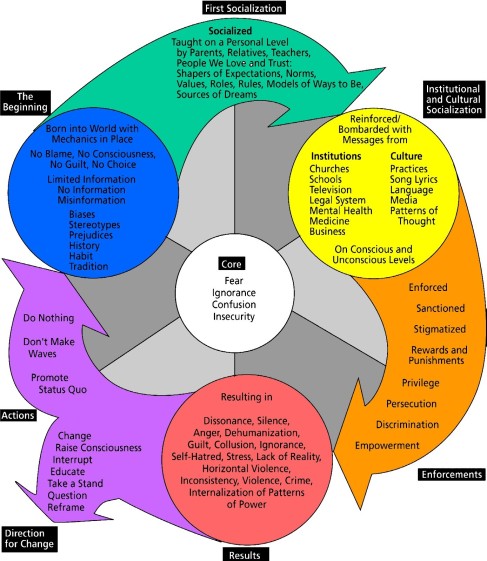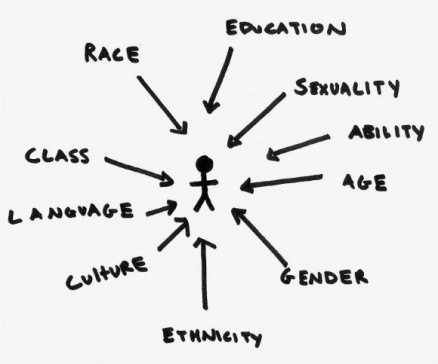By Nalani Love
As activists many of us know we live in a white, heteronormative, euro, cis, andro centric world where everything that is white, cis, straight, western, and masculine centered is seen as right, given power then labeled as the dominant groups. In comparison anything that does not assimilate to these molds are seen as wrong, disadvantaged and labeled as the subordinate groups. Now you might ask “Nalani what does any of this have to do with this intersectionality that you speak of?” Well in order for you to understand what intersectionality is and how it relates to you, you must first understand how people are socialized into their identities.
The Cycle of Socialization
Growing up you may have been like me learning that you are identified based on how you are perceived by society. For example, because I was designated male at birth (meaning I was born with a penis) society deemed that I must be a man and because I am deemed a man who is attracted to people that identify as men or are masculine of center society would then say that my sexual orientation would be gay. Which would be incorrect because I identify as agender and I am queer, which is still kind of gay but not exactly. The way people are taught about identities is through socialization and the most common way people are socialized is through the cycle of socialization.

The cycle of socialization as defined by Harro is how people “get systematic training in “how to be” each of our social identities throughout our lives.” This cycle is made up of seven parts: The Beginning, First Socialization, Institutional and Cultural Socialization, Enforcements, Results, Actions, The Core of the Cycle, Choosing the Direction for Change.
The Beginning
The Beginning starts as you being born into a world that already has systems in place that are suppose to dictate your gender, class, sexual orientation, religion, ability status and so on without you having any say in the matter. In this system those with power, the dominant groups, control the rules and are considered the norm. Individuals in this group are born with the privilege of already being in power. Those that are disadvantaged, the subordinate groups, are expected to follow the rules of the dominant group because they are deemed the norm.
First Socialization
Following this is First Socialization. This would be early childhood where you start to shape who you are based on how you socialize with the people that are around you while you are being raised. You use the people around you as role models to discern how you should act by how you relate to them and how you perceive yourself. For instance children designated male at birth are raised as boys and growing up they notice that they are the same as their father, older brother or other close male relative because of the similarity in dress such as short haircuts and masculine clothing. They then mimic the actions and behaviors of their male figure to learn how boys act. Until the child reaches autonomy they are heavily influenced by the people around them.
Institutional and Cultural Socialization
As we grow and start to interact with society by attending school, practicing religion and recreational activities like sports and art we encounter institutional and cultural socialization. This is when we learn the status quo of the world around us like what is considered to be “normal” and what is to be “weird”, the difference in how girls and boys are “supposed” to act, who we should “look up to” and who to “look down on” and a host of unfair roles, rules and assumptions based off of the institutions we interact with. This is the time in our youth where we are taught stereotypes of things about race, gender, and sexuality through the media, language, music, and cultural practices are acceptable which leads to the enforcing oppressive ideas on ourselves and others.
Enforcements
Over time you, just like myself, may have come to the realization that you do not agree with society’s stereotypes of race, gender, and sexuality or any of the oppressive messages that you have been spoon fed and want to breakaway from it. The only thing stopping you from breaking away are the enforcements set in place by society to punish you if you go against the grain. An example would be when women advocate that they should not be objectified and force to appeal the male gaze. They are seen as stepping out of a “woman’s place” by having the audacity to voice their opinion and prude for not taking a man’s “compliment” making it seem that it is women’s fault if they feel offended by sexism. Enforcements work by singling anyone out that acts against the norm then painting them as the problem when in actuality it is society that is the problem.
Results
The results of systematically learning are destructive. The subordinate groups feel helpless because if they go against the norm the same stereotypes that oppress them will be used to make their argument of injustice invalid however should they stick to the norm they are conforming to and reinforcing those same stereotypes which perpetuate the system of oppression. This leads subordinate groups to oppress themselves from within causing internalized oppression. As for dominant groups, they come to realize and feel guilty that they have unearned privilege and are being oppressive and fear that there will be backlash in which they will be seen as “the bad guy.” Due to this fear dominate groups do not think past this point or try to interrupt the cycle.
Choosing the Direction for Change
At the end of this cycle there are only two actions you can take. You can decide to perpetuate societal norms and continue the cycle of socialization that you would later help to enforce upon future generations. Or you can be the change you want to see in the world and disregard all the hate and shaming society will throw at you for going against the grain.
By deciding to stop the cycle of socialization you are choosing the direction for change. You have decided that instead of fearing and conforming to societal norms that you will challenge these norms because they are wrong and there are so many different ways identities can form outside of society’s narrow views of race, gender, and sexuality.
Intersectionality

Now that you have the knowledge of the cycle of socialization we can move into intersectionality!
Intersectionality can be explained as the intersecting of systems of oppression depending on a person’s identities, meaning that two or more identities that a person has does not take away from each other but in fact intensifies each other and cannot be examined separately. When people think about oppression they usually only think of it in a narrow sense as in only one identity can be effected by a one type of oppression. But they never think about how people can have multiple identities and how by having multiple identities can increase the types of oppression you face.
Take me for example I am black, queer, and agender that has the intersecting identities of being black, queer, and gender non-conforming which are all oppressed identities that have to be taken into account as to how they each affect me. As a black person I experience racism, being queer I experience homophobia and I experience gender inequality because my gender identity is constantly invalidated and taken as a joke. I don’t deal with these forms of oppression separately I have to deal with them all at once because I have multiple identities. It is important to remember that humans have so many identities. Some have five, ten, or even fifteen different identities that all affect each other.
You
Now this is where you come in. After going through this you now know how identities are formed by society and that people can have numerous identities which leads to them facing many forms of oppression at once. This is important because as activists you have to understand that in order to dismantle oppression you must dismantle all forms of oppression. You cannot dismantle one form of oppression and expect everything to be all hunky-dory afterwards.
One thought on “Intersectionality – The Overlapping of Identities, Oppression & You”